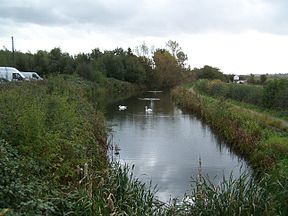Nottingham Canal
| Nottingham Canal | |
|---|---|

Part of the Nottingham Canal is maintained for Fishing. Pictured in 2006.
|
|
| Specifications | |
| Maximum boat length | 85 ft 0 in (25.91 m) |
| Maximum boat beam | 14 ft 6 in (4.42 m) |
| Locks | 19 + 1 stop lock |
| Status | parts in use / nature reserve / infilled |
| History | |
| Principal engineer | William Jessop |
| Date of act | 1792 |
| Date completed | 1796 |
| Date closed | 1937 |
| Geography | |
| Start point | Langley Mill |
| End point | Nottingham |
| Connects to | River Trent |
The Nottingham Canal was a 14.7-mile (23.7 km) long canal between Langley Mill in Derbyshire and Nottingham, England. Construction began in 1792 and was completed in 1796, overrunning its budget by 77% The canal left the River Trent to serve a number of wharves in Nottingham, and then rose through a further 18 locks to reach a long upper pound. At its upper end, a stop lock connected it to the Great Northern Basin, which provided access to the Erewash Canal and the Cromford Canal.
Traffic increased slowly, but from 1804 was sufficient to enable dividends to be paid to the shareholders. A warehouse in Nottingham was destroyed in 1818, when a cargo of gunpowder exploded, causing severe damage to the surrounding area. Competition from the railways began in the early 1840s, and rather than face continual decline, the company sold the canal to the Ambergate, Nottingham, Boston and Eastern Junction Railway. A series of amalgamations took place, and by 1861, the canal was owned by the Great Northern Railway, who did little to maintain it. Although 123,488 tons were carried in 1916, most of it was short-haul traffic between the Trent and the wharves of Nottingham. There were regular complaints about water levels on the lower section, but the railway did nothing to resolve the issues.
Ownership passed to the London and North Eastern Railway in 1923, who had no interest in a partly moribund canal, and in 1937, they abandoned the main line. The section from Lenton to the Trent was leased to the Trent Navigation Company from 1936, and sold to them in 1946. Nottingham City Council bought the section from Lenton to the city limits and began filling it in from 1955. 6 miles (9.7 km) of the upper section was bought by Broxtowe Borough Council, to retain it as a public amenity. There was a brief attempt at re-opening the upper section for navigation, but the construction of the Awsworth Bypass in 1980 severed the canal, and the plan became unworkable. Part of the upper section was subsequently destroyed by open-cast mining of coal.
...
Wikipedia
